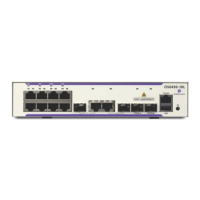Configuring VLAN Router Interfaces Configuring VLANs
page 4-10 OmniSwitch AOS Release 7 Network Configuration Guide March 2011
Configuring VLAN Router Interfaces
Network device traffic is bridged (switched) at the Layer 2 level between ports that are assigned to the
same VLAN. However, if a device needs to communicate with another device that belongs to a different
VLAN, then Layer 3 routing is necessary to transmit traffic between the VLANs. Bridging makes the
decision on where to forward packets based on the destination MAC address of the packet; routing makes
the decision on where to forward packets based on the IP network address assigned to the packet,
for example, IP - 21.0.0.10.
Alcatel-Lucent switches support routing of IP traffic. A VLAN is available for routing when at least one
router interface is defined for that VLAN and at least one active port is associated with the VLAN. Up to
eight IP interfaces can be configured for each VLAN.
If a VLAN does not have a router interface, the ports associated with that VLAN are in essence firewalled
from other VLANs. For information about how to configure router interfaces, see
Chapter 11, “Configuring IP”.

